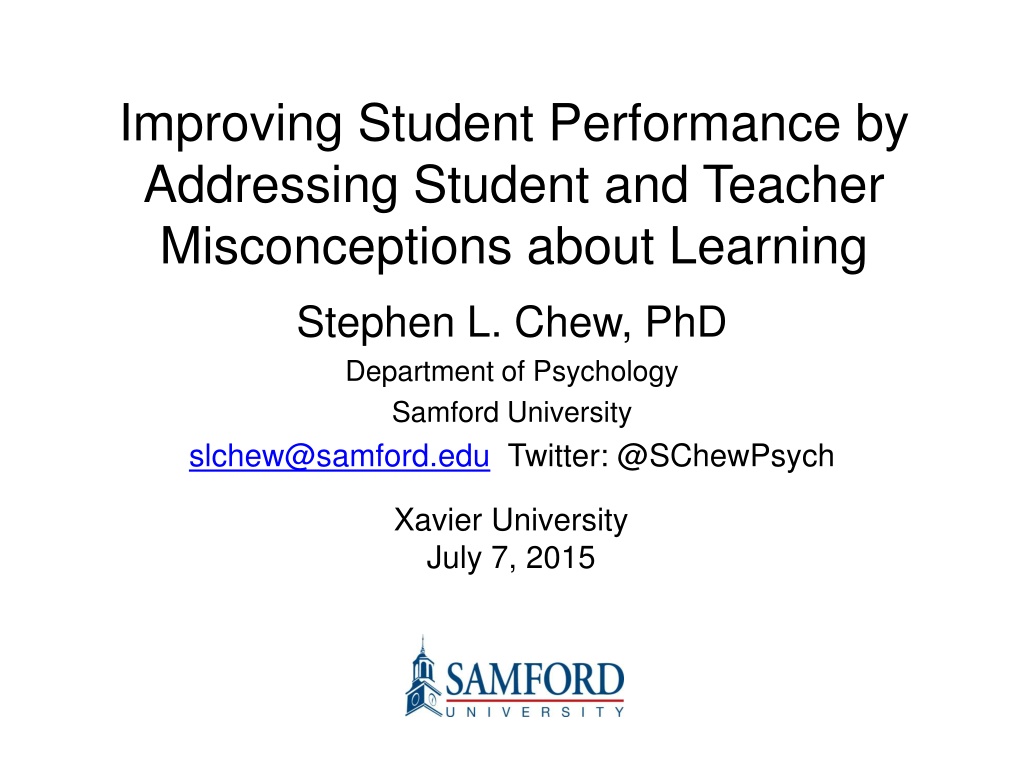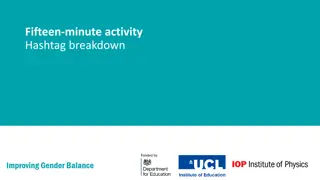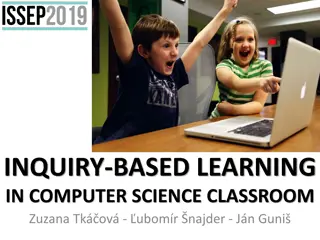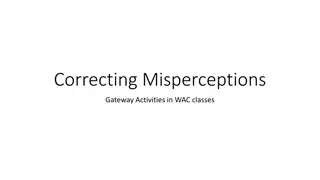Understanding Student and Teacher Misconceptions in Learning
Addressing common misconceptions about learning can improve student performance. This session explores cognitive principles for effective learning and teaching, including the impact of teacher and student beliefs on learning outcomes. Insights into college student readiness and challenges are also discussed.
- Student Performance
- Teacher Misconceptions
- Effective Learning
- Cognitive Principles
- College Readiness
Download Presentation

Please find below an Image/Link to download the presentation.
The content on the website is provided AS IS for your information and personal use only. It may not be sold, licensed, or shared on other websites without obtaining consent from the author. Download presentation by click this link. If you encounter any issues during the download, it is possible that the publisher has removed the file from their server.
E N D
Presentation Transcript
Improving Student Performance by Addressing Student and Teacher Misconceptions about Learning Stephen L. Chew, PhD Department of Psychology Samford University slchew@samford.edu Twitter: @SChewPsych Xavier University July 7, 2015
Goals for this Session 1) Discuss common teacher and student misconceptions about learning 2) Discuss cognitive principles of learning students need to understand to become more effective learners. 3) Discuss cognitive principles of learning teachers should know to improve pedagogy 4) Discuss how to put principles into practice using formative assessments and exam wrappers
Three Kinds of Knowledge for Effective Teaching Knowledge of Your Field Effective Teaching Knowledge Of How People Learn Knowledge of How People Learn Your Field
Teacher Beliefs about How People Learn Teaching requires a mental model of how people learn. Determines which teaching methods are selected, how they are implemented and assessed, and how to adjust if there are problems.
Student Beliefs about How People Learn Students also base their study behavior based on their models of how people (specifically themselves) learn. It determines their learning effectiveness, achievement, and success
A typical incoming college student Has graduated from high school with an average GPA of 3.00 (NAEP, 2009) Has probably passed a high school exit or graduation exam Has been tested for scholastic achievement or aptitude many times Probably taken an entrance exam and was admitted to college
% of Students Deemed Ready for College by ACT (2014) 70 64 60 50 44 43 % Prepared 37 40 26 30 20 10 0 English Mathematics Reading Science All four areas
A typical college freshman is Inadequately prepared for college work Unaware of the fact because it is contrary to their successful high school experience Likely overconfident in their preparation and abilities for college-level work Few students enter college believing they will struggle
Typical Student Messages I came into the test really confident that I knew the material but it didn't show that on the test. The reason I have stuck with the course this long is because I believe I have put a lot of effort towards studying for the exams is just I haven't tested well. I felt prepared going in to the first two exams but scored much lower than I wanted to (and much lower than the class). To be completely honest, I have not wanted to come to class because I do not feel it is worth it if I am not going to do well anyways.
The Primary Goal of Teaching Either To present information that students are solely responsible for learning Or To develop a sophisticated, useful, and generative level of understanding on the part of the students Distinguish between teaching that makes it easy for students to learn vs. teaching that makes it easy to make a good grade
How to help students make a successful transition to college Remediation Teach them to adjust through college transition courses, advising, study skills centers, and other resources Personal and social adjustment; study tips , and time management Teach them how to be more effective learners by correcting misconceptions and teaching them cognitive principles of learning
Video Series: How to Get the Most Out of Studying http://www.samford.edu/how-to-study/
The Challenges Overcome student misconceptions about learning Give students a coherent, research-based framework for developing effective learning strategies in any situation More than disconnected study tips Show them how to apply the framework to their study Make the videos engaging, accessible, and memorable Do it in 5 7-minute videos
How to Get the Most Out of Studying Webpage: http://www.samford.edu/how-to-study/ Introductory Video: Developing a Mindset for Successful Learning Video 1: Beliefs That Make You Fail Or Succeed Video 2: What Students Should Understand About How People Learn Video 3: Cognitive Principles for Optimizing Learning Video 4: Putting the Principles for Optimizing Learning into Practice Video 5: I Blew the Exam, Now What?
Beliefs about Learning that Make You Stupid Learning is fast Being good at a subject is a matter of inborn talent rather than hard work, Knowledge is composed of isolated facts I m really good at multi-tasking, especially during class or studying
Attentional Blink Switching attention is time consuming and effortful 20 alerts and you ve wasted an hour (without checking anything) The average Facebook visit is about 20 minutes 3 visits and you ve wasted an hour Checking texts, twitter, etc. wastes at least a few minutes every time There is no such thing as a momentary distraction
Metacognition A student s awareness of his or her level of understanding of a topic Metacognition distinguishes between stronger and weaker students One of the major tasks for a freshman is developing good metacognition In high school, students spent years developing a metacognitive sense that is likely inadequate or even counterproductive for college.
Self-Rating What is your best, most accurate judgment of the percentage of questions that you answered correctly on this exam? Your answer may range from 0 to 100% _____________________% correct
Estimated and Actual Grades for 800 Students: Econ 101
The irony of poor metacognition Students who have the poorest metacognition have no clue how weak their understanding of a concept is. Part of being incompetent is not understanding just how incompetent you are. So the students who most need to listen closely to this talk are the ones who don t believe they need to. (The same holds true for teachers)
So how accurate are your beliefs about how people learn?
Which of the following is the MOST important ingredient for successful learning? 1. The intention and desire to learn 2. Paying close attention to the material as you study 3. Learning in a way that matches your personal Learning Style? 4. The time you spend studying 5. What you think about while studying
Read the instructions for the demonstration to yourselves and do your best to follow them.
Rate each word Does the word contain an E or G? Do you find the word Pleasant?
Levels of Processing Shallow processing focuses on spelling, appearance and sound. Rote memorization of facts Flashcards with isolated facts Deep processing focuses on subjective meaning. Relating new information to prior knowledge or other information Making information personally meaningful
Rate each word Does the word contain an E or G? Do you find the word Pleasant? Shallow processing: You are focusing on spelling. Deep processing: You are relating the words to your own meaningful experiences. These are orienting tasks that cause you to think in deep or shallow ways, regardless of your intention
Intention vs. Level of Processing Intentional Incidental 80 69 68 70 67 60 50 43 % Recall 39 40 30 20 10 0 Shallow: E Checking Deep: Pleasantness Level of Processing Control
Which of the following is the MOST important ingredient for successful learning? 1. The intention and desire to learn 2. Paying close attention to the material as you study 3. Learning in a way that matches your personal Learning Style? 4. The time you spend studying 5. What you think about while studying
Implications for Learning Intention and motivation to learn are not important Attention and amount of study is necessary, but not sufficient for learning Learning strategy has a huge impact on learning Shallow study strategies trump good intentions Deep level of processing is critical for learning
Implications for Students Many students have highly practiced poor learning strategies Studying more won t help Increase overconfidence without learning They need to unlearn highly practiced old strategies and develop new, more effective ones Consider study skills in terms of orienting tasks and level or processing
These findings are strongly counterintuitive All study is effective, only amount, intensity, and desire matter Motivation automatically improves study effectiveness Effort equals learning Learning is hard work, but not all hard work leads to learning
Implications for Teachers Teaching skill matters, and matters greatly Pedagogy has a significant impact on learning, for better or worse Consider pedagogy in terms of orienting tasks and level of processing Design assignments, problem sets, questions, examples to induce deep processing
Achieving Deep Processing while Studying As you study, follow these principles: Elaboration: How does this concept relate to other concepts? Can I make a story? Distinctiveness: How is this concept different from other concepts? Personal: How can I relate this information to my personal experience? Appropriate to Retrieval and Application: How am I expected to use or apply this concept?
These are principles for deep processing, but not a recipe There is no set recipe for effective studying or effective teaching What constitutes effective study will depend on the student, the subject, and the assessment What constitutes effective teaching will depend on the teacher, the students, their mindset, the subject, and the learning goal
So shouldnt we design pedagogies that make students use deep processing all the time? (What faculty need to know about learning)
What are the critical factors in student learning? Engagement Active learning Struggle Many faculty take pride in how hard they make students struggle Assumes struggle leads to better learning
Cognitive Load Theory (e.g. van Merrienboer & Sweller, 2005) Mental effort is the amount of concentration that a person has available to devote to tasks Mental effort is always a limited resource Cognitive Load is the total amount of mental effort a task requires to complete it A person can do multiple tasks at once as long as the total cognitive load does not exceed available mental effort If cognitive load exceeds available mental effort, then performance suffers
Student mental effort must meet the demands of instructional cognitive load Available Mental Effort Cognitive Load of Teaching Extraneous Load Teachers design instruction Must be less than Limited Resource Germane Load Intrinsic Load Tasks and concepts possess difficulty
Name the days of the week out loud and in order as fast as you can
About this Activity Were you engaged? Were you engaged in active problem solving? Were you working hard and struggling? What was the 4th day in the list?
Name the Days of the Week as Quickly as You Can In Alphabetical Order 1) Friday 2) Monday 3) Saturday 4) Sunday 5) Thursday 6) Tuesday 7) Wednesday
Implications of Cognitive Load Theory If the cognitive load demanded of students exceeds their available mental effort, then learning will not occur If the cognitive load demanded of students takes up most or all of available cognitive effort, then there will not be enough mental effort available for learning or schema formation Teachers must monitor, manage and minimize cognitive load to allow schema development as well as design activities to promote schema development
Deep Processing and Cognitive Load Deeper level of processing causes better learning (good) but also greater cognitive load (bad) All High Impact practices have high cognitive load Shallow Processing Less Learning Less Cognitive Load More Learning More Cognitive Load Deep Processing
Cognitive Load of Various Tasks (adapted from Piolat, Olive & Kellogg, 2004) Planning Revising Translating Composing a text Notetaking from a lecture Task.. Playing Chess (experts) Playing Chess (novices) Reading a text Reading sentences Intentional learning Incidental learning Text Copying 0 100 200 300 400 Cognitive effort (IRT in ms.)
How do we deal with cognitive load? Deliberate Practice leads to automatic thinking Deliberate practice is intentional practice with the goal of improving a skill. Not mindless drill The goal must be apparent to the student, or the student must trust the teacher With large amounts of practice, a skill becomes automatic and no longer requires metal effort. Expertise is based on automatic processing
About Engagement, Active Learning, and Struggle Engagement, active learning, and mental struggle do not always lead to effective learning Neither does deep processing if cognitive load is too great Teachers must balance deep processing and cognitive load
The Complexity of Teaching The number of teaching methods is large and diverse No teaching method is without limitations and pitfalls Teaching is a contextual interaction; Teaching effectiveness involves the dynamic interaction of multiple factors: the outcomes that are desired by the characteristics of the students by the characteristics of the instructor by the curriculum and content No single best way to teach
The TACOMA Model of Teaching (Teaching as a Contextual Outcome of Multiple Agents) Characteristics of the Teacher In-the-Moment Reflection Pre-event Reflection Topic, Content, and Learning Goals Monitor, Manage, Manipulate Manipulate Monitor Manipulate Teaching Strategies Characteristics of the Learner Form of Assessment Learning Strategies Post-event Reflection Level of Student Understanding Student-Teacher Rapport and Classroom Atmosphere
An Effective Teacher Must monitor, manage, and manipulate multiple, conflicting factors, many of which are outside the teacher s control, to achieve desired learning goals Must be knowledgeable about multiple teaching methods and make adjustments during teaching.
Take Home Message, Part 1 Students and faculty have misconceptions about learning that undermine effectiveness Presented a more sophisticated understanding of how people learn Teaching is a complex interaction of factors that the teacher must manipulate, manage, and monitor























